L.A. County plans to make hospitals report superbug infections

- Share via
Los Angeles County plans to require hospitals to begin reporting when patients are infected with a certain superbug so lethal that it can kill half its victims, health officials said Thursday.
Unlike two dozen other states, California has not required hospitals to report when patients are sickened with the lethal bacteria, which federal officials warn is one of the nation’s most urgent health threats.
The hospitals will be advised of the new reporting requirement “in the next few months,” said Dawn Terashita, deputy director of the county’s acute communicable disease control program.
The change comes after The Times reported Sunday about how Manhattan Beach resident Sharley McMullen was sickened with CRE, or carbapenem-resistant enterobacteriaceae, after a May 2014 surgery at Torrance Memorial Medical Center.
McMullen’s daughter said she called the county’s public health department to report her mother’s infection, but was told it wasn’t a reportable disease. McMullen died from the CRE infection after spending five weeks in the hospital, mostly in the ICU, according to her medical records.
The county had stopped requiring hospitals to report CRE infections in 2012 “due to resource limitations,” according to officials, although some hospitals had continued to voluntarily submit bacterial samples from patients stricken with the superbug.
Terashita said that the county does not plan to release the names of the hospitals reporting the CRE infections except in rare cases. “If we feel there is some reason to have the hospital identified to protect the patient then we would,” she said.
She said health officials will use the data to “look for clusters of infections and prevent outbreaks.”
Nursing homes and clinics won’t be required to report when their patients are infected with CRE, Terashita said.
California does not track how many patients die from infections acquired in hospitals. And the county will not require hospitals to report whether patients with CRE die or survive, Terashita said.
The Centers for Disease Control and Prevention estimates that 75,000 Americans with hospital-acquired infections die during their hospitalizations each year. Some experts have challenged that number, saying it underestimates the number of deaths.
Since late 2014, CRE has caused three outbreaks at Los Angeles County hospitals, including at UCLA Ronald Reagan Medical Center, where three patients died. Those outbreaks were traced to a type of medical scope that has been shown to be especially difficult to disinfect.
McMullen had two scope procedures just before her surgery at Torrance Memorial Medical Center.
Torrance Memorial officials did not answer questions about whether other patients were sickened but said they had ruled out medical scopes as the source of McMullen’s infection. They said the hospital “takes patient safety, particularly as it relates to infection control, very seriously.”
Because of CRE’s high risk, the CDC has advised local health officials to require health facilities to report such cases. And if that’s not possible, health departments should still survey hospitals and nursing homes for the presence of the superbug to make sure the facilities are trying to stop its spread, according to the agency’s guidelines.
CRE cases gathered from 2010 to 2012 showed that L.A. County was “a high prevalence region” for the superbug.
County officials said they had already been working to prevent the infections, including by sending public health nurses to hospitals to consult on potential outbreaks and proper infection controls.
Follow @melodypetersen on Twitter
ALSO
Judge deals blow to former Manson family member’s latest bid to win freedom
Earthquakes in California are discovered more than 15 miles deep. Here’s what that could mean
Deputy chief of state rail authority will leave by end of the year
More to Read
Inside the business of entertainment
The Wide Shot brings you news, analysis and insights on everything from streaming wars to production — and what it all means for the future.
You may occasionally receive promotional content from the Los Angeles Times.











